How Finland became Russian. Failures and victories of the Russian-Swedish war 1808-1809
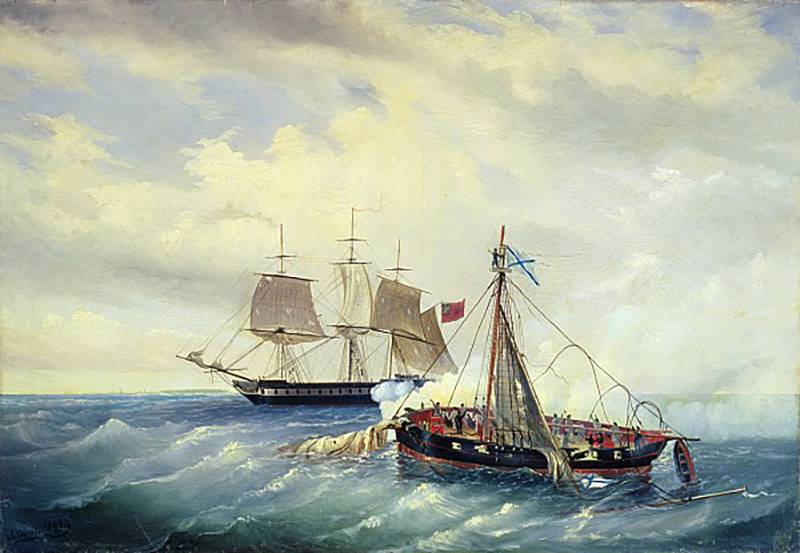
The Russian-Swedish war was not a major military conflict, with which the Russian story. In this war, large-scale battles with the participation of many thousands of armies did not occur, and the long columns of linear fleets did not exchange full-fledged volleys. At this very time, Napoleon's battalions marched across Europe in horror under the bravura "La Victoire est a Nous!" The Pyrenees were already engulfed in guerrilla warfare. And, looking at these events, Austria was already preparing for trying military happiness. The last Russian-Swedish war proceeded far from the epicenter of the all-European events, but its course was closely watched by diplomats, the military, and those “who followed.” Formally, Russia was in a state of war also with the Ottoman Empire, but at the time of the outbreak of hostilities with Sweden, Petersburg and Istanbul were in armistice mode.
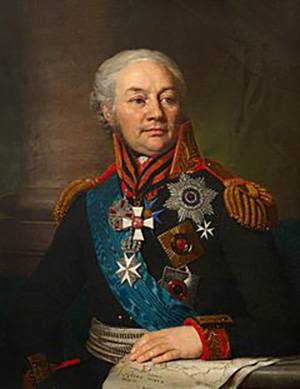
The main goal of Alexander I was to annex Finland and free the capital of the empire from any revenge incitement from Sweden once and for all. For the war on land, both sides had rather limited contingents of troops, and the specifics of the theater of operations, logistics issues and organizations made their own adjustments. The Russian land army, intended for operations against Sweden, reached the number of 24 thousand people, the command over which Alexander I ordered the General of Infantry Count Fyodor Fedorovich (Friedrich Wilhelm) von Buxgevden. Coming from an old Ostsee clan, the count was considered to be a sufficiently experienced military leader at court. He graduated from the Artillery and engineering gentry cadet corps, distinguished himself in the battle of Bendery, for which he was awarded the rank of engineer-lieutenant in 1770. The following year, 1771, during the assault on Brailov, being wounded, remained on the battlefield and destroyed two enemy weapons - for this young Buxgewden was presented to the Order of St. George 4 degree. Subsequently, he was adjutant of Grigory Orlov, a favorite of Catherine II. He took an active part in the Russian-Swedish war 1788 – 1790. and in the Polish campaign, where he commanded the infantry division. For the difference in the assault under the leadership of Alexander Suvorov of Prague, a suburb of Warsaw, he was awarded the Order of Vladimir 2 degree and a gold sword with diamonds. In 1794 – 1796 served as commander of Warsaw and the governor of Poland. Under Emperor Paul I, the Earl fell into disfavor, left the service and went abroad. However, with the accession of Alexander returned and was granted the rank of general of infantry.
The total number of Swedish troops stationed in Finland did not exceed 19 thousand people. They were generally led by General Klöckner. Despite the general negative rhetoric against Russia, the Swedish army continued to be dispersed throughout the garrisons and fortresses.
9 February 1808 The Russian army crossed the border with Sweden in the area of the river Kyumen. Already a few days later, in a night battle with 15 on February 16, a decisively defeated Swedish enemy unit near the village of Artchio was defeated. Buksgevden formed a special detachment under the command of Major General Count Orlov-Denisov to capture Helsingfors. This city was the reference and logistics center of the entire Swedish grouping in Finland. In submission Orlova was Eger and Cossack regiments, along with a squadron of dragoons. With a forced march, a detachment of Major General marched towards Helsingfors, making the transitions on the ice. On the outskirts of the city of February 17, Orlov-Denisov smashed and scattered the Swedish squad, taking field guns as 6 trophies and taking prisoners of 134. February 18 Russian troops entered Helsingfors. In the arsenal, 20 guns and a large amount of gunpowder, bombs and nuclei were taken.
The Swedish commander, General Klöckner, was confused and lost control of his troops. At the end of February, 1808 was replaced by a more proactive and active general, Count Wilhelm Moritz Klingspor. While personnel changes took place in the Swedish command, the team of Major General Shepelev 10 of March occupied Abo.
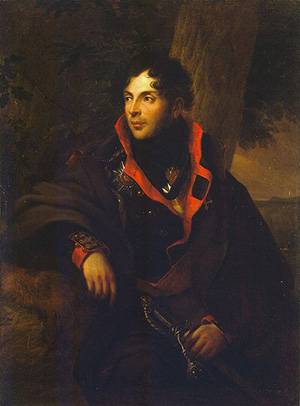
After this event, it was finally communicated to the subjects of the empire that the country was at war with the Swedish kingdom. The royal manifesto indicated that Sweden had refused, along with Denmark and Russia, to close the Baltic Sea’s waters to British ships, thereby depriving it of the “sea world”, and other hostile actions of the Stockholm court were mentioned. It was reported that, having exhausted all possible arguments for persuasion, Russia was forced to resort to force. After a short time, 16 March 1808, a new manifesto was published. It was reported that in response to the clearly not friendly actions of Sweden, namely: refusal to fulfill the contract from 1800, allied relations with England, at war with Russia, arrest of the Russian ambassador in Stockholm and all of the embassy Finland is declared a territory annexed to Russia. According to the manifesto, Finland joined the empire “for all time”.
Meanwhile, in the theater of warfare, luck was accompanied by Russian troops. 20 February two divisions under the command of Lieutenant General Nikolai Mikhailovich Kamensky laid siege to the most powerful Swedish fortress and naval base in Finland - Sveaborg. The Swedes were justifiably proud of their creation, pathetically calling it “Northern Gibraltar”. By the beginning of the siege, the garrison of Sveaborg numbered about 7,5 thousand people and almost 200 guns. The fortress was in sufficient quantities supplied with provisions and gunpowder. Sveaborg was taken under heavy blockade and subjected to methodical bombardment. After 12 days of shelling, the garrison under the command of Vice Admiral Karl Olaf Kronstedt capitulated. The Swedes were released to their homeland with the traditional promise not to take in hand weapon until the end of the war. Impressive trophies were taken in Sveaborg: in addition to impressive fortress stocks and weapons, a Swedish rowing boat deployed here for the winter was captured flotilla numbering over 100 pennants. In addition, in other parts of Finland, the Swedes themselves burned and scuttled about 70 more rowing vessels.
Aland demarche and Gotland adventure
However, the first months of the war were marked not only by successes - there were misfires and obvious failures. After the capture of Abo, a small detachment of Swedes took refuge in the Aland Islands. Behind him were sent in pursuit of the Cossacks Major Pavel Ivanovich Neidgardt and the Yeger battalion under the command of Colonel Nikolai Vasilievich Vuich. 17 February Vuich took control of the city of Aland on the islands and destroyed the station of the optical telegraph that communicates with the Swedish coast. Significant warehouses were taken under control. After the success, the command and staff leapfrog began, as Prince Bagration's immediate superior, Prince Bagration, ordered him to leave the archipelago, and he returned to the mainland. Immediately he came to the order, already emanating from the capital itself: take the island immediately. According to the command of command, control over the islands could prevent the possible transfer of enemy troops to Abo on the ice. Vitch returned to the islands with the same battalion of Jänders 26 of the Chasseurs Regiment and a cavalry detachment of Cossacks and hussars. Located on the island of Kumlinge, in the heart of the archipelago, the colonel made him his base. Hold another island and he did not have sufficient strength.
As spring approached, Commander-in-Chief Buksgevden was about to return the Vuitch detachment, because, due to the imminent opening of navigation, his stay on the Aland Islands lost meaning. However, the Swedish command was also aggressively trying to knock out the Russians from the archipelago located close to their own coast. After a short time, when movement on the water became possible, the Swedish galleys approached the island of Kumlinge, from which a landing party was landed. Under cover of naval artillery and with the active participation of armed local residents, the Swedes attacked the Vuicha detachment. The forces were too unequal, and after two hours of battle, the colonel surrendered. 20 officers were captured and about 500 lower ranks. The Swedes strengthened the archipelago as it should, and later on it became the operational base for the enemy fleet.
Another unsuccessful event of the Russian-Swedish war was the Gotland adventure. Since France and Russia after the Tilzitsky world were albeit temporary, but allies, the French ambassador in St. Petersburg considered it right to give “efficient” advice, which was not always so. One of such valuable comments was the outlined idea of the desirability of capturing the island of Gotland. The inconsistency of the plan lay in the fact that by this moment the Russian fleet was still ice-bound in Kronstadt and could not provide cover for the enterprise seizing the remote island from the sea. Still, the opinion of the French partners was heeded: by the highest order of 20 in March 1808, Rear Admiral Nikolai Andreyevich Bodisko was ordered to land troops on Gotland island in order to prevent England from using it for his fleet. At the same time, the solution of the technical side of the issue (the rear admiral was not allocated a single transport ship) entirely fell on the shoulders of Bodisko himself. The commander of the expedition was able to charter 9 commercial vessels in Vindawa and Libau for the transport of an amphibious assault force. For the capture of Gotland, two battalions of the Koporsky infantry regiment and one battalion of the 20 of the Tersky regiment were allocated (a total of 1657 people with 6 field guns).
April 10 transport fleet secretly approached Gotland and landed paratroopers in the north-western part of the island. It should be noted the absence of any cover from the fleet - the Swedes could have known about this undertaking, they could have intercepted the defenseless convoy with a pair of frigates. Bodisko detachment passed almost 70 km and occupied Visby without a fight. The rear admiral declared himself governor of the island. At the same time, in Riga, he was preparing to send a second convoy with reinforcement units: two infantry companies, two hundred Cossacks and 24 field guns. The second echelon was supposed to leave 8 May from Riga also without ship cover, counting on luck and ignorance of the Swedes.
Meanwhile, Stockholm became aware of the events on the island of Gotland and King Gustav IV was expected to become enraged by the fact of the landing of the Russian troops. This state of affairs was declared completely unacceptable, and the Swedish monarch ordered to recapture Gotland as a matter of urgency. As soon as the ice situation allowed, a squadron of three battleships, two frigates and several transports with more than 2 thousand soldiers left the island from Karlskrona. The command was carried out by Rear Admiral Olaf Rudolf Söderström. The Swedish commander acted tactically competently, singling out from his forces two ships with the aim of carrying out a demonstrative landing on the northeast coast of the island. Bodisko considered that the enemy would be landed in this place, and advanced most of his troops there. This is exactly what Söderström wanted - the Swedish troops landed in a completely different place, in Sandviken Bay. Immediately a significant number of armed locals joined the enemy troops, reinforcing their ranks. After a couple of days, Bodisko went to the surrender negotiations, finding his chances of keeping the island equal to zero. Besides, it was not possible to wait for any help from the fleet. The conditions of surrender for the Russian troops were very mild: it was necessary to hand over all the weapons and ammunition, but they kept the banners with them. After which the detachment Bodisko went to Russia. Upon arrival, the rear admiral was put on trial, expelled from service, stripping officials and awards, and exiled to Vologda. The fact that the entire Gotland expedition, without the support of the fleet and the corresponding preparation, was an adventure prompted, besides, by a foreign ambassador, was somehow not paid attention.
From war to truce - and again to war
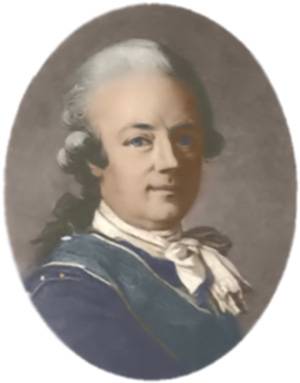
In the summer of 1808, King Gustav IV tried to change the course of the campaign in his favor, although it was very difficult. Despite the tactical successes on the Aland Islands and Gotland, the general course of the war was very unfavorable for Sweden. Denmark, after last year’s “courtesy visit” by the British fleet, finally moved from neutrality to the camp of the opponents of Albion and became an ally of France. So the Swedes needed troops to cover their border with the Danish Norway, and therefore could allocate very limited forces for operations against Finland occupied by Russian troops.
8 June 1808 d. The 4-thousandth detachment with the 8 guns of Major General Baron von Fegezak landed in 25 km from Abo, after which he moved to the city along the coast. On the way, the Swedes got a battalion of Libavsky Infantry Regiment with one gun under the command of Colonel Vadkovsky. The Russian detachment steadfastly resisted the superior forces of the enemy assault and was able to hold the enemy until reinforcements from several infantry battalions, cavalry detachments and artillery arrived. Swedish sabotage in the Russian rear fell through - Baron von Fegezak was forced to retreat to the landing site and dive into ships under the cover of naval artillery. Other attempts to carry out landings in the Russian rear ended in failure.
In August, 1808 in Finland took place, in fact, the largest battle of this campaign, called the battle of the village of Oravais. In early July, the Swedish troops under the command of General Klingspor and with the active participation of the Finnish partisans managed to press the Russian troops. July 12 commander Lieutenant-General Count N. M. Kamensky began command over the group in central Finland. At the end of August 1808, Kamensky, who put his troops in order, defeated the Swedes near the village of Kuortane and forced the enemy to retreat almost 50 km. Klingspor entrenched north of the village of Oravais in a comfortable position: its right flank rested against the Gulf of Bothnia with several gunboats there, and the left was protected by steep cliffs with dense forest. The number of Swedish troops reached more than 7 thousand people. The Russians had a little more than 6 thousand. Kamensky's troops were on the march, pursuing the enemy, because they entered the battle piecemeal and in stride.
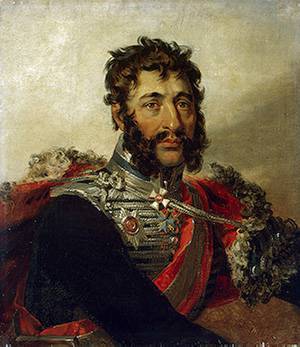
At 8 in the morning of August 21, the advance guard under the command of General Yakov Petrovich Kulnev attacked the enemy. His attack was repelled by the Swedes, and they even tried to counterattack. Two infantry regiments under the command of General Nikolai Ivanovich Demidov went to the aid of the vanguard and overthrew the enemy. At 3 o'clock in the afternoon, Klingspor tried to attack again, but the main forces of the Russian troops had already arrived at the scene of the battle together with Kamensky. Another enemy counterattack was repulsed with heavy losses - twilight fell on the battlefield. At night, General Demidov, despite the difficult terrain, began to bypass the Swedish left flank through the forest. In the morning, the Swedes discovered Russian troops that had already threatened their flank and rear. Dropping part of the weapons and equipment, Klingspor retreated.
In September, a new setback awaited the Swedes. At the beginning of September, a five thousand strong Swedish landing force commanded by General Bona landed near Abo. To raise the morale of the court with the troops accompanied the royal yacht "Amanda" with King Gustav IV on board. Initially, the operation proceeded successfully - small Russian patrols were forced to withdraw as the enemy approached. However, on September 16, a landing party was attacked by troops under the command of Bagration at the town of Khimais and put to flight. The pursuit of the enemy was carried out by cavalry, mercilessly chopped the fugitives. About a thousand Swedes were killed, around 400 - captured. The 5 guns became Russian trophies. Artillery fire from the shore forced the enemy's galleys to leave before the evacuation was completed. The defeat of the landing took place actually in the eyes of the king himself, who was watching what was happening on board his yacht. All this made a depressing impression on the monarch. Soon, General Klingspor proposed a truce through trucers to Buxgevden.
In late September, a temporary cease-fire agreement was concluded between the warring parties. However, Alexander I was very dissatisfied with the “willfulness” of Buxgevden, and the commander received a strict order to continue the fighting. The offensive of the Russian troops was continued, the Swedes retreated to the depths of the territory. At the beginning of November, negotiations with the Swedes were again begun, and this time, Bugsgevden acted more cautiously, having enlisted in advance support and permission from St. Petersburg. Nevertheless, at the court the count was not satisfied, and he was dismissed from his post as army commander with the appointment of Lieutenant-General Count N. M. Kamensky instead. The truce was concluded in the village of Olkioki 7 on November 1808 for up to December 7. Under the terms of the agreement, the Swedish army left the province of Österbotten in 100 km north of Uleaborg, which was occupied by Russian troops. The Russians pledged not to invade Swedish Lapland. December 3 truce was extended until March 1809.
Sea and skerries
The Baltic Fleet met the war in far from the best shape, since most of its best and most efficient ships were sent as part of the Second Archipelago Expedition under the command of Admiral Senyavin. The ship fleet consisted of a total of 9 battleships, 7 frigates and 25 smaller ships. Quite to the numerous rowing fleet (more than 150 units) it was prescribed to protect the coastal flank of the Russian army, and after taking Abo - and this port from attack from the sea. Of the Swedish ships captured in Sveaborg, two detachments were formed, the command over which was taken personally by General Buksgevden. It was they who had to repel the first attacks of the enemy rowing fleet on Abo.
The first clashes occurred near the islands of Gango and Hirvisalo 18 and 22 June, respectively. The Swedish rowing flotilla of Admiral Gielmstierna, having in its composition towed barges with a landing force, tried to break through to Abo. In both clashes, the Swedes had a numerical advantage (14 versus 23 and 26 versus 58). Unable to reach their goal, the Swedes began blocking Abo, taking control of all the fairways leading to the harbor. The enemy chose the coast of the Jungfersund strait for its operational base. Nevertheless, to strengthen the Russian naval grouping covering Abo, a rowing squadron was sent in the number of 40 ships under the command of the captain of 1 rank Count Heyden. To avoid meeting with the superior forces of the enemy, who pulled even A part of the fleet from Karlsrkun to block Abo, Heyden chose the path between Kimito Island and the mainland. It was known that even in the time of the Northern War this place was littered with stones and was impassable for the ships in the Heyden detachment. Previously impassable fairway was forced by the Russian squad after two days of exhausting work. Appearing in an unexpected place for the Swedes, the Russian detachment managed to break through in Abo. During an exchange of fire with enemy gunboats, Count Heyden was wounded, and the command of the detachment was temporarily assumed by Lieutenant Commander Dodt. The task of blocking the Abo by the Swedes and preventing the Russian reinforcements from breaking through there was thus disrupted. Further military operations of the Russian rowing fleet under the general command of Rear Admiral Alexei Efimovich Myasoedov were successful, and until late autumn 1808, he guarded the Finnish skerries from the enemy.
The ship fleet, unlike the previous Russian-Swedish war, did not act so actively, because it did not have sufficient forces and initiative combat admirals, for whom the insufficiency of its own forces did not present any serious interference. 14 July 1808, commanded by Admiral P.I. Khanykov, from Kronstadt left a squadron consisting of 9 battleships, 11 frigates, 4 corvettes and 15 smaller ships. Khanykov received a very specific instruction, ordering "to try to destroy the Swedish naval forces or to seize them, first of all connecting them with the British, to clear the Finnish skerries from enemy ships and to promote ground forces to prevent the landing of the enemy landing."
The Swedish ship fleet by this time was already at sea. It consisted of 11 battleships and 5 frigates. The mention of the English in the instructions was not an accident. A British squadron consisting of 16 battleships and 20 other ships entered the Baltic Sea. Two British ships sailed to join the Swedish fleet, and the rest went on an independent cruise to the shores of Pomerania.
Soon, Admiral Khanykov received a completely different instruction, which in fact leveled his initial and main task: mastering the sea. The new order ordered the admiral to coordinate all his actions with the commander of the land army, General Buxgevden. In fact, the fleet was deprived of independence in their actions and completely began to depend on the ground command. The results of such a dubious decision were not long in coming. Buksgevden categorically demanded that Khanykov, instead of fighting for the mastery of maritime rule, move into the Gulf of Bothnia to prevent the landing of enemy landings. The thing is that, together with the English squadron, the expeditionary corps of General Moore arrived in the Baltic Sea, loaded onto transports. Moore was supposed to assist the Swedes in the defense of Finland, but the British were late - by the time they appeared, this territory had already been taken by the Russian troops. Then, despite the insistent requests of King Gustav IV, the British troops were sent to the shores of the Iberian Peninsula to counter the French corps of General Junot.
The Russian fleet reached Gangut, where for two weeks assisted the rowing forces. Several ships were sent to cruise on enemy communications. They managed to capture the 5 transport ships and their escort brig. Then Khanykov went to Jungferzund. However, time, an irreplaceable resource, was missed - two British battleships joined the Swedish ship fleet, and now the enemy squadron from the 13 battleships and 6 frigates left the skerries already in search of the Baltic Fleet. Admiral Khanykov, considering the correlation of forces clearly not in his favor (he had only 9 battleships and 6 frigates), since part of his forces had to allocate Count Buchgevden for the needs, August 13 left Eastgund for East.
The Russian squadron was moving towards the Baltic port (now Paldiski) and on the morning of August 14 was already on its way to it. On its tail were Swedish and English ships. The previously damaged 74-gun ship of the line Vsevolod was towed by the frigate Pollux. Six miles from the Baltic port, the tug-rope burst, and the Vsevolod had to anchor. From the other ships of the squadron, already sheltered in the harbor, boats and longboats for towing were sent to the emergency battleship. However, the British ships "Implakabl" and "Centaur" managed to attack the "Vsevolod" to the approach of help.
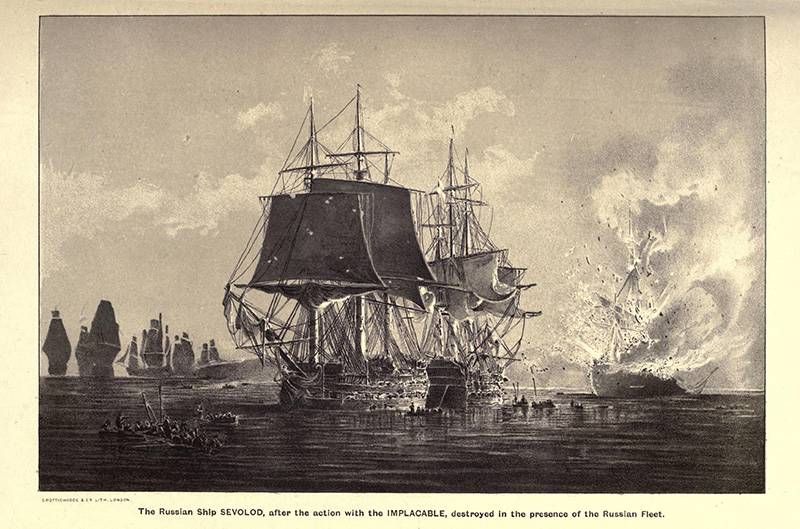
The commander of the Russian ship decided to defend himself to the last and was able to ground it on his own. The British damaged the battleship with artillery fire, and then went to board the ship. "Vsevolod" was captured only after a bloody hand-to-hand combat. Unable to remove the Russian ship from the ground, the British burned him. Nevertheless, the Allies had to abandon the intention to attack the Khanikov squadron in the Baltic port - the Russians built additional coastal batteries, and booms were installed at the entrance to the raid. In early October, with the onset of autumn storms and the beginning of a shortage of provisions, the Anglo-Swedish squadron was forced to lift the blockade from the Baltic port and go to Karlskrona. In fact, it was the only battle in the entire war for the linear forces and the enemy.
After the war, a trial was held against Peter Ivanovich Khanykov, where the admiral was accused of a number of omissions. First of all, he was charged with the fact that he allowed the Swedish and English ships to unite. But in fact, Khanykov carried out instructions from St. Petersburg, which instructed him to coordinate all his actions with Buxgevden, practically subordinating the fleet to the coast. The ships entrusted to him were in a very mediocre technical condition - all the best were subordinate to Senyavin. In the end, the court, taking into account various circumstances, mitigated the original insulting wording: “who is from laziness, stupidity or slowness, but without stubbornness, envy and intent ...”. The case was consigned to oblivion, and the admiral was dismissed.
In 1808, there was another bright battle episode in the sea in which the British appeared. The 14-gun "Experience" under the command of Lieutenant Gabriel Ivanovich Nevelsky was sent to monitor the British raiders entering the Gulf of Finland. 11 June in overcast weather near the island Nargen “Experience” met in the fog with the British 50-gun frigate “Salset”. The British demanded to surrender and lower the flag, but Lieutenant Nevelskoy accepted an unequal battle. The wind, which had temporarily subsided, allowed the boat to break away from its pursuer at oars, but soon it became fresh, and the frigate quickly caught up with the low-speed "Experience." There was a stubborn four-hour battle, the boat was captured by the British - only after receiving severe damage in the mast and hull. Part of the crew was killed, the rest of the crew, including Lieutenant Nevelsky, were injured. As a sign of respect for such courageous opponents, the British, generally not inclined to sentiment, released the commander of the "Experience" and all his subordinates.
Despite certain setbacks, on the whole, the war was moving towards victory for Russia. In the next 1809, the Russian army made an unprecedented transition on the ice of the Gulf of Bothnia, already threatening the Swedish capital directly. Forces, resources, and the Swedes didn’t have a desire to continue the war, and their parliamentarians appeared in the location of the Russian army right during the march across the ice. In Stockholm, a coup d'état occurred: stubbornly unwilling to make peace with the Russians, Gustav IV was overthrown, and his uncle, Charles XIII, took his place on the throne in the Russian-Swedish war of 1788 – 1790. commanded the Swedish fleet.
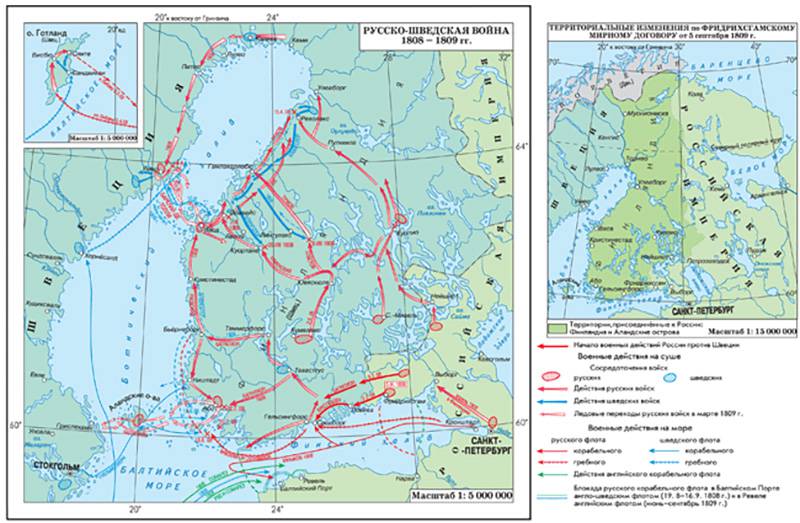
3 September 1809 in Friedrichsgam signed a peace treaty, which gave Finland, the Åland Islands and part of Västerbotten to the Russian Empire. The union of Sweden and Denmark with Napoleonic France was consolidated. Thus, the loss of all the senyavin achievements in the Mediterranean and the Adriatic was partially offset by the acquisition of Finland. Another question is that its population was much less loyal to Russia than the subjects of the Republic of the Seven Islands. A respite in the north for Russia was short-lived. On the threshold was the Patriotic War of 1812, the Borodino field, the fire of Moscow and the inevitable Berezina.
Start here: https://topwar.ru/99005-kak-finlyandiya-stala-russkoy-nakanune-russko-shvedskoy-voyny-18081809-gg.html
Information